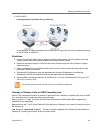
Defining Cascading Conferences
Polycom®, Inc. 239
If a flag is not listed in the System Flags list it must be added to the system.cfg file before it can be modified.
For more details on defining system flags, see Modifying System Flags.
Star Cascading Topology
In the Star topology (as well as in the Basic topology), the MCUs are usually installed at different locations
(states/countries) and participants connect to their local MCU to facilitate the connection and save long
distance call costs. Star Topology Cascading requires that all cascaded MCUs reside on the same network.
Content sharing is available to all conferences over the H.323 Cascading Link.
In this topology, the MCUs are networked together using two modes:
● Master-Slave Cascading
● Cascading via Entry Queue
Master-Slave Cascading
It is similar to MIH (Multi Hierarchy) cascading, with only two levels: one Master MCU on level 1 and several
Slave MCUs on level 2.
The cascading hierarchy topology can extend to four levels (MIH Cascade - a Sample 3-Level Cascading
Configuration) and should be deployed according to the following guidelines:
● If an RealPresence Collaboration Server is deployed on level 1:
RealPresence Collaboration Server systems can be used on level 2
MGC with version 9.0.4 can be used on level 2 if RealPresence Collaboration Server version 7.0.2
and higher is deployed in level 1
● If an MGC is deployed on level 1:
MGC or RealPresence Collaboration Server can be used on level 2.
Although participants in Star Cascading conferences can connect to their local conference using IP
(H.323, SIP) and ISDN, the Cascading Links between conferences must connect via H.323.


















